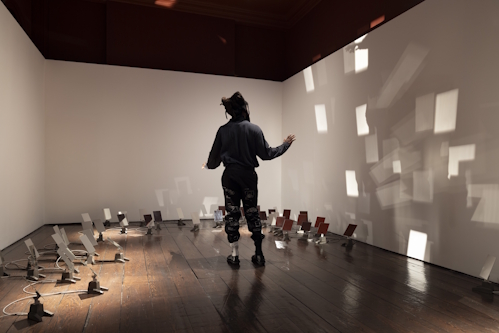Somerset House, London
When algorithms begin to see, our bodies become echoes of data
Curated by Wayne McGregor in collaboration with Google Arts & Culture Lab, Infinite Bodies is an exhibition where technology learns to look. There is no trace of romantic futurism, nor any nostalgia for the pre-digital past. It is cool, precise, almost transparent, an experiment on how humanity might be seen anew.
The first work is OMNI. Two dancers move within a vast dark screen, their skeletal frames traced by light. No skin, no expression, only rhythm and motion. Created with Industrial Light & Magic, McGregor’s work captures the dancers through cinematic motion technology, feeding that energy into AI to generate a ‘body without gravity.’
It is beautiful in a way that feels almost cold. Every turn, every lift, every encounter glows with points of light like particles of data in dialogue. This digital duet becomes the exhibition’s point of origin and the birth of a question: when connection becomes data, where does emotion reside?
I stood watching the virtual skeletons draw close, then drift apart, as if observing a newly evolved species. It has no soul, yet understands rhythm; no warmth, yet performs a simulation of connection.
After this virtual duet ends, in the next room light replaces the body and begins to breathe.
Future Self (2012), a collaboration between McGregor, Random International and composer Max Richter, is a light sculpture that responds to movement. A grid of one hundred thousand LEDs traces every motion of the visitors and folds them into patterns of light.
I watched my outline being redrawn in light. It was like a mirror, yet even more like a form of perception learning to perceive. For a moment, it seemed to capture my aurora, a field of energy I was not even sure existed. The light was learning me, as I was learning to be seen. Here, the boundary between dancer and audience dissolves, and every breath, every flicker, becomes an echo.
McGregor’s question remains clear: when technology acquires perception, what still defines us as human?
After passing several other installations, I entered a room filled with moving mirrors.
This work, Audience (2008), created by Random International and curated by McGregor, feels like a living system made of reflections. The moment I stepped in, they turned towards me, startlingly alive. Each mirror was a curious face peering back. Except every face was my own. I had been multiplied into a crowd. It was a kind of magnified loneliness. The AI had created an audience but not an Other. What I saw was an infinite extension of myself.
I laughed. The moment was too precise, too absurd. Technology had succeeded in showing me that we no longer need external observers. Each of us watches ourselves within the mirror.
Audience is more than an interactive installation; it is an ethical model. In the age of AI, looking has become a form of self-surveillance. Yet those curious, turning mirrors remain oddly endearing.
At the end is the kinetic structure A Body for AI (2025), a collaboration between McGregor and artist Ben Cullen Williams, combining moving sculpture, photography and AI-generated imagery.
A vast metallic form slowly rotates in the air like a drifting satellite. Silver panels reflect and refract light, folding it into new configurations. On their surfaces played a sequence of hybrid memories: the lines of dancers’ bodies, threads of data, mountain textures, urban fractures. Humanity and the world reconstructed by algorithms.
I watched the images shift, overlap and breathe. It was a training in seeing, and I could not look away. AI was learning how to see humans, while I was learning how to see its vision of the world. Between the breath of light and machinery, the line between looking and being looked at dissolved.
I thought of Ryoji Ikeda, whose installation data-cosm [n°1] can presently be seen not far away at 180 Studios. In his work, the human is erased, leaving only the order of data. In his universe, noise itself is human. McGregor’s satellite, however, restores the human to the frame, not erased but quantified.
A Body for AI felt like a philosophical experiment. It seemed to whisper that seeing itself is a designed act. When we gaze at images created by AI, we are also learning its logic of perception.
I reached the exit and pushed open the door. Light stilled, sound faded, every computation ceased. Air became air again.
At that moment I realised the true subject of Infinite Bodies is not technology but seeing itself. AI is not only creating art; it is learning to see. Once technology learns to look, humanity becomes the observed species.
Yet something remains outside the algorithm. Presence, imperfect, unstable, unpredictable.
Light can simulate skin, data can simulate breath, but existence cannot be simulated.
Perhaps this is the structure of the soul: light passes through us, leaving shadow, and as we turn back to face it, we learn again what it means to be human.
Wayne McGregor’s ‘Infinite Bodies’ is at Somerset House, London to February 22, 2026.
Extending the experience is ‘On the Other Earth’, an installation at Stone Nest in London’s West End, of which more soon.
Ryoji Ikeda’s data-cosm [n°1] is at 180 Studios, 6 Surrey Street, London (near Somerset House) 180 to December 21, 2025.




